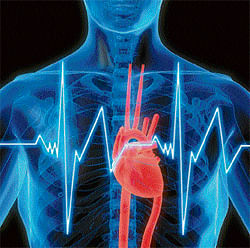Dr Venkatesh explains in detail, the connection between high blood glucose and cardio vascular diseases.
Cardio Vascular Disease, CVD, is a major complication of diabetes and the leading cause of early death among diabetic patients — about 65 per cent of them die from heart disease and stroke. Adults with diabetes are two to four times more likely to suffer a stroke than those without the ailment. High blood glucose in adults with diabetes increases the risk of heart attack, stroke, angina and coronary artery disease.
People with Type 2 diabetes will show a high rate of blood pressure, lipid problems and obesity, which can have a combined effect on the occurrence of CVD. Smoking doubles the risk.
According to scientific studies, the risk of heart disease and stroke is twice as high in diabetic patients than those without it, or non-diabetics. Two out of every three diabetic persons are affected with the two ailments, statistics show.
There are several other risk factors which aggravate the situation and result in critical consequences. These risk factors can be categorised as modifiable risk factors and non-modifiable risk factors.
The former are ones which you can control to enjoy a better health condition, whereas latter are the ones out of your control. Non-modifiable risk factors will always be there, and other than taking some preventive actions, you cannot really do much about them. Let me present some insights on the two types of risk factors.
Modifiable risk factors
Following is a list of risk factors which can be controlled and maintained at a safe limit by proper medication or change in lifestyle or by restricting food habits.
*Obesity: Obesity should be a serious concern for patients of diabetes, particularly if it is noticed in the central part of the body. Central obesity is related to accumulation of fat in the abdominal area.
In this situation, the risk increases because abdominal fat is responsible for increasing the level of bad cholesterol or LDL. With a high level of LDL, there is more deposition of fat inside the blood vessel, creating an obstruction in the circulation system. This automatically gives rise to cardiac problems and increases the risk of stroke.
*Abnormal cholesterol level:Abnormal cholesterol levels can also increase CVD risk or risk of having a stroke. High level of LDL can build up more fat on the walls of blood vessels, leading to disruption in blood circulation. In some cases, the arteries get completely blocked and as a result, little or no amount of blood can flow beyond that area.
Triglyceride is another component of cholesterol which also affects the heart when present in high levels.
However, the good cholesterol, or HDL, has the power to clear up the deposited fat from the blood vessels. But with a lower level of HDL, the risk can be quite high.
*Hypertension: High blood pressure is another associated risk factor in this regard. This situation puts extra pressure on the heart for proper functioning and can deteriorate the health of the heart and simultaneously increase the risk of heart failure.
*Smoking: Diabetes and smoking is a bad combination. Both cause the narrowing of blood vessels by increasing fat deposition on the blood vessels. The risk is double in such cases.
Non-modifiable risk factors
There are several non-modifiable risk factors, for which you cannot do anything.
nAgeing: Increased age is one of the risk factors for diabetic patients, as the heart gets weaker with age.
The risk of a stroke also increases to double for a person over 55
nFamily history: If there is family history of heart disease or stroke, then the risk becomes higher. Particularly, if any of your closed family members has suffered a heart attack or stroke within the age of 55 (male) or 65 (female), then you could be at risk.
nGender: Gender is also another significant factor in this case.
Normally, men are at a higher risk than women who are at their pre-menopausal stage
Now that you know of these risk factors, you can surely take the necessary actions to control them. There are several medications and treatments available by which you can take care of the modifiable risk factors. Clinical trials are being conducted for diabetes, heart disease and stroke to learn about the benefits of newly-discovered medications in this respect.
Precautions
Eating right for diabetes comes down to three things:
*What you eat. Your diet makes a huge difference! You should eat mostly plant foods, cut back on refined carbs and sugary drinks, and choose healthy fats over unhealthy fats.
*When you eat. Diet is part of it, but keeping regular meal and snack times also affects your blood sugar levels and will help to keep them more constant.
*How much you eat. Portion sizes matter. Even if you eat healthy meals, if you eat too much, you will gain weight, which is a risk factor for diabetes.
You do not need to eat special foods, but instead simply emphasise on eating more vegetables, fruits and whole grains. A diabetes diet is simply a healthy eating plan that is high in nutrients, low in fat, and moderate in calories.
(The contributor is a consultant cardiologist at Fortis Hospital.)
